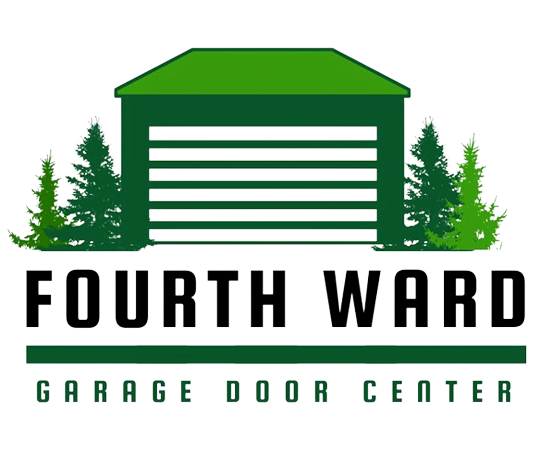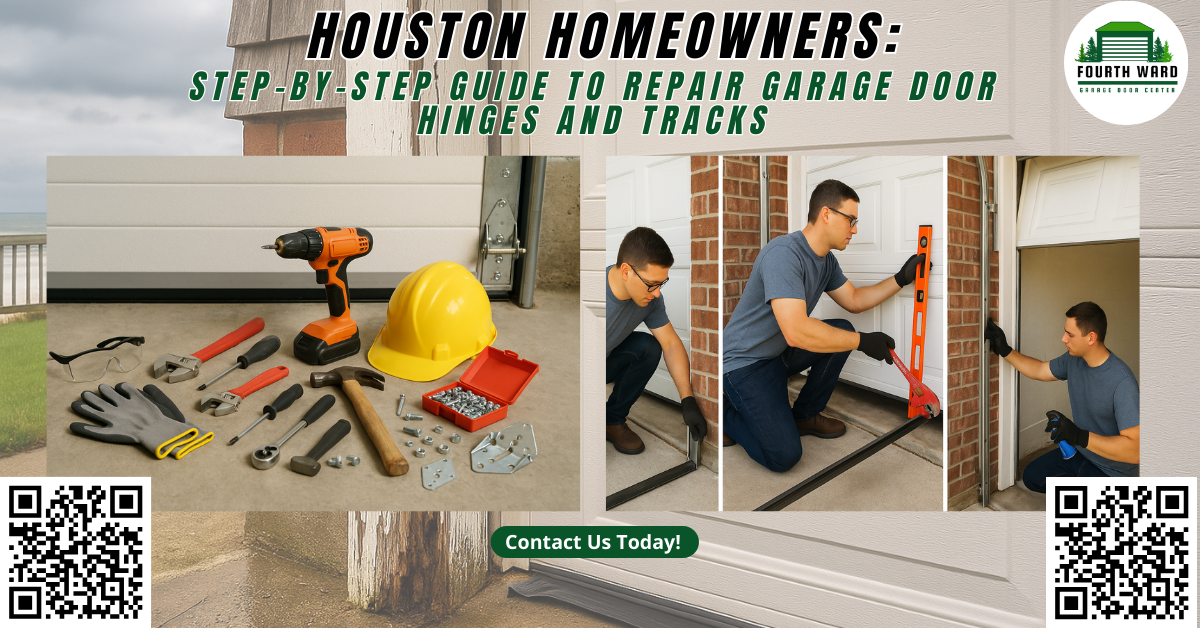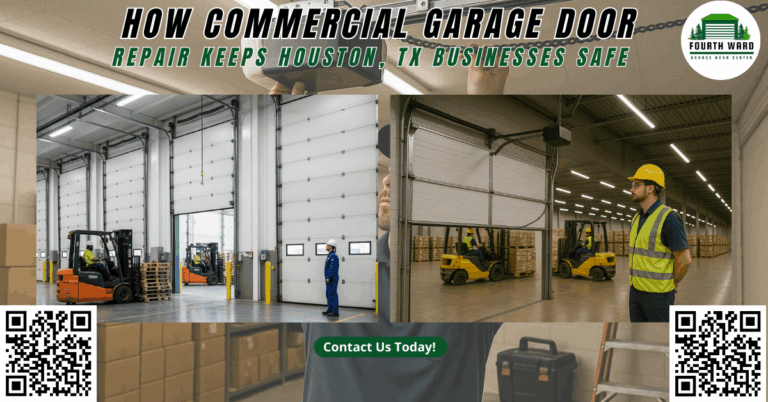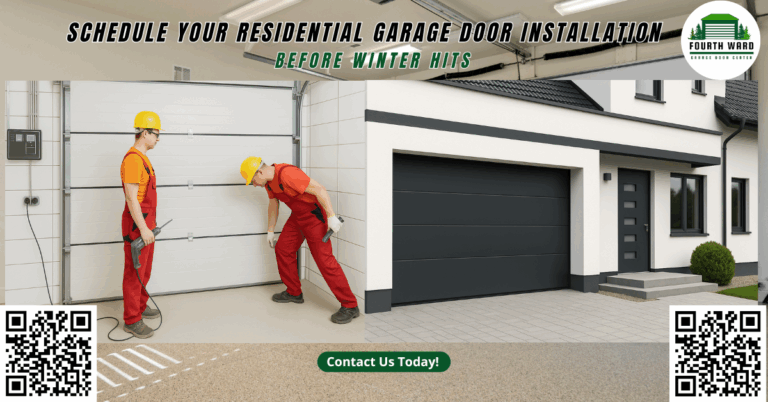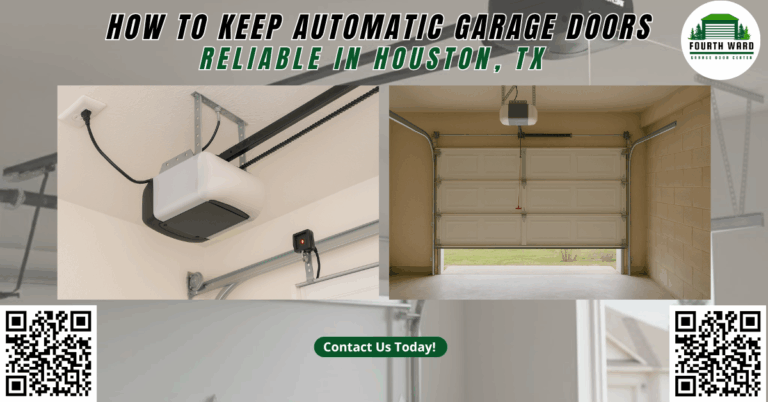When a Simple Hinge Becomes a Serious Problem
One weekend in Houston, a homeowner in the Fourth Ward neighborhood experienced a loud snap from her garage door as she tried to head out for errands. The garage door had frozen mid-motion and appeared slanted. Our trained technicians arrived promptly and discovered that two critical hinges were worn and fractured, while the adjacent track had shifted from its original alignment. Although the malfunction started small, the entire garage door system was compromised. Our team stepped in to repair garage door components, restore proper alignment, and return the system to safe and dependable operation. This situation highlighted how even the smallest issues with garage door components can escalate into serious safety hazards and costly repairs. Ignoring these seemingly minor signs often results in homeowners being locked out of their own garage or worse, dealing with property damage.
The Hidden Costs of Ignoring Small Repairs
Research from the International Door Association shows that nearly 70 percent of all garage door failures in the United States originate from neglected maintenance of essential components like hinges, rollers, and tracks. When homeowners overlook minor signs such as grinding noises or sticking panels, they are often left with larger problems, such as a broken garage door, a compromised garage door opener, or jammed rollers. These conditions not only affect the smooth operation of your door but also put your safety and property at risk. Proper garage door maintenance and prompt attention to warning signs can extend the life of your system and reduce the need for emergency garage door services.
Additionally, a malfunctioning garage door can affect energy efficiency in your home. When a door does not close properly due to worn hinges or misaligned tracks, it allows drafts, moisture, and even pests to enter your garage. This could lead to increased heating or cooling costs and deterioration of stored items. The financial burden of avoiding repairs also includes possible damage to the garage door opener motor, springs, or panels, all of which are significantly more expensive to replace than a hinge or bracket.
Why This Guide Matters for Houston Residents
In a humid and often storm-prone region like Houston, metal parts used in garage doors are susceptible to rust, corrosion, and wear. This makes regular inspections and timely repairs even more critical. Homeowners in this area must be proactive about checking for signs of moisture damage, especially after heavy rainfall or periods of high humidity. If garage door hinges begin to rust, it can spread to surrounding components, leading to system-wide issues. Similarly, when garage door tracks expand slightly in Houston’s heat and contract during cooler nights, the alignment can shift over time.
As a trusted provider of garage door service and repairs, Fourth Ward Garage Door Center is proud to offer homeowners a complete, easy-to-follow guide to repairing garage door hinges and tracks. Whether you are dealing with noisy garage door components, worn rollers, or loose hardware, this guide provides actionable insights to help you take care of your garage door system. The information shared here is designed not only to help with small repairs but also to educate homeowners about their garage door system’s overall function and maintenance needs.
Understanding Garage Door Hinges and Tracks
What Are Garage Door Hinges?
Garage door hinges are essential components that connect the individual panels of sectional garage doors. These hinges allow each panel to pivot as the door opens and closes along its track. Depending on the location of the hinge, they are typically numbered from #1 near the bottom to higher numbers near the top. The higher-numbered hinges bear more load and experience greater tension during movement. A damaged hinge can lead to misalignment of the entire garage door and cause severe functional problems.

Hinges may also vary by material, with most being made from galvanized steel for rust resistance. Some heavy-duty or commercial garage doors may use thicker-grade steel or even stainless steel for increased durability. It is crucial to match hinge types and numbers exactly during replacements to ensure that the load distribution across the door panels remains balanced. Improper hinge replacements can compromise safety and reduce the garage door’s life span.
What Do Garage Door Tracks Do?
Garage door tracks are metal rails mounted on either side of the door opening. These tracks guide the rollers and keep the garage door on a consistent path during opening and closing. The vertical tracks guide the door upward, while the horizontal tracks guide it back into the ceiling. If tracks become bent, loose, or misaligned, the rollers may come off, leading to uneven movement or door jams. Tracks are critical to the structural integrity and safe operation of the garage door system.
There are two main types of track systems, standard radius and high-lift. Standard radius tracks are used in most residential garages, while high-lift tracks are found in commercial or specialized home setups with high ceilings. Each type requires specific angles and mounting brackets, and improper repairs can affect balance and movement. Tracks must be aligned perfectly parallel to one another and free of debris to function efficiently.
Recognizing the Signs of Hinge and Track Problems
Identifying problems early can prevent damage to other parts of the garage door system. Here are common warning signs:
- Unusual Noises: If you hear grinding, squeaking, or popping noises, your hinges or rollers may be dry or damaged. This is often the first sign of metal-on-metal friction, which eventually wears down your parts.
- Door Misalignment: If your garage door appears crooked or uneven, it could indicate track misalignment or broken hinges. The door may also rub against the frame or leave a gap on one side.
- Visible Damage: Rust, cracks, or broken components should be addressed immediately. Over time, rust eats away at metal, weakening the component’s ability to support weight or maintain alignment.
- Rollers Jumping or Wobbling: If your rollers are not gliding smoothly, your tracks may be out of alignment. Wobbly rollers can eventually pop out of the track, leaving your door stuck or partially open.
Keep in mind that these issues tend to cascade; what starts as a small problem with one hinge can quickly affect other parts of the garage door system, such as springs, cables, or even the garage door opener itself.
Tools and Safety Gear You Will Need
Before beginning any garage door repairs, gather the following tools and safety gear:
- Adjustable wrench for loosening and tightening bolts and nuts
- Socket set for accessing hard-to-reach bolts with precision
- Flathead and Phillips screwdrivers for removing screws of various types
- Level to ensure your tracks are perfectly aligned
- Rubber mallet for gently tapping bent tracks into place
- Penetrating oil or garage door lubricant to loosen rusted components and prevent wear
- Safety goggles to protect your eyes from debris or snapping parts
- Work gloves to prevent cuts, blisters, or contact with sharp edges
- Replacement parts such as hinges, brackets, or track segments, if existing ones are too damaged
- C-clamps or locking pliers to keep the garage door secure during the repair process
It is also advisable to wear closed-toe shoes, especially when working under or around a suspended garage door. Keep a clean workspace and never allow children or pets near the area while repairs are underway. Safety sensors should be tested after every repair to confirm they still work properly and detect obstructions.
Step-by-Step Guide to Repairing Garage Door Tracks
Step 1: Evaluate the Problem
Begin by visually inspecting the garage door tracks. Look for bends, dents, or separation from the wall brackets. Use a flashlight to check inside the tracks for debris, rust, or roller misalignment. Listen for screeching or clicking sounds that may indicate areas where the rollers are sticking or jumping out of place.
Step 2: Tighten Loose Brackets and Screws
Loose mounting brackets can lead to wobbling, uneven movement, and even track collapse. Use a socket wrench or drill with the appropriate bit to secure all fasteners. Inspect the wall or ceiling surface where the brackets attach for signs of wear or water damage, which can reduce holding strength.
Step 3: Realign the Track with a Level
Using a bubble level, check that your vertical tracks are perfectly straight. If they lean in or out, the rollers may rub against the edges, causing resistance. Loosen the bolts just enough to shift the track gently into alignment, then retighten securely. For horizontal tracks, ensure they slope slightly toward the back of the garage to assist in guiding the door back when fully open.
Step 4: Repair Small Dents or Bends
Using a rubber mallet, tap out small dents that may prevent smooth roller operation. For more stubborn damage, insert a block of wood into the track as a backing and gently hammer against it. This prevents further deformation of the track. If the damage cannot be corrected or the track is significantly warped, replacing that section is the best option.
Step 5: Lubricate and Test the Tracks
After repairs are complete, clean the inside of the track with a cloth to remove dust and metal debris. Apply a light coat of garage door lubricant along the track surface. Manually open and close the door several times to check for smooth, quiet motion. If the door catches or wobbles, recheck alignment and bracket tightness.
Bonus Tip:
For homes in Houston, where weather and humidity can impact metal over time, consider investing in rust-resistant or stainless-steel track systems. These hold up better in coastal or high-moisture environments and reduce long-term maintenance needs.
Avoiding Common Mistakes During Repairs
Garage door repairs can be straightforward with the right preparation, but mistakes can lead to injuries or further damage. Many homeowners attempt quick fixes without fully understanding the mechanics of their garage door system. Here are frequent errors to avoid:
- Failing to Disconnect Power: Always unplug the garage door opener before working. Accidental activation could cause the door to move and result in serious injury.
- Using Incorrect Hinges or Parts: Each hinge on a sectional door has a specific role. Using the wrong hinge number or a poor-quality replacement part can result in uneven door movement or mechanical failure.
- Overtightening Screws and Bolts: Applying too much force can strip threads or crack mounting surfaces, especially on wooden doors. Use controlled pressure and the right tool.
- Ignoring Rust and Moisture Damage: Surface rust may seem minor, but it often indicates deeper corrosion. Inspect all parts regularly and replace compromised components.
- Using Household Oils Instead of Garage Door Lubricant: Standard oils like WD-40 are not suitable for long-term garage door lubrication. They may dry out or attract dust. Use a product designed specifically for garage door systems.
Being aware of these common pitfalls can save time, protect your garage door system, and help avoid costly repairs or replacements in the future.
Staying Safe While Performing DIY Garage Door Repairs
Working on your garage door may appear simple, but safety must be your priority. Garage doors are heavy and contain high-tension components that can cause injury if mishandled. Here are essential safety tips:
- Avoid Spring Adjustments: Never attempt to repair or adjust torsion springs or extension springs on your own. These parts are under extreme tension and can snap without warning. Always call a professional.
- Secure the Door Panel Before Removing Hardware: Use C-clamps or locking pliers to stabilize the panel. This prevents the door from collapsing or shifting while you work.
- Wear Proper Protective Equipment: Safety glasses protect against flying debris, and gloves shield your hands from sharp edges and pinch points.
- Keep the Workspace Clear: Tools and parts should be organized. Remove all obstacles to ensure you have full mobility around the garage door.
- Test the Safety Sensors After Repairs: After completing any repair, verify that the garage door safety sensors are aligned and functioning correctly. This ensures the opener will stop if anything crosses the door’s path.
If you are ever uncertain about your ability to complete a repair safely, call a local garage door expert who can assess the situation and recommend the best course of action.
When to Call a Professional Garage Door Repair Service
Certain situations require the expertise and equipment of a licensed technician. Some garage door problems are too complex or dangerous for DIY efforts. Call a professional if:
- The door will not open or close completely and shows signs of misalignment or hardware failure
- You notice frayed or snapped cables, or the door appears to be hanging unevenly
- The garage door opener motor is straining or making loud noises, but not moving the door
- Springs are damaged or show signs of rust, separation, or slack
- Panels are cracked, warped, or heavily water-damaged

Professionals have access to specialized tools like spring winders, track measurement devices, and high-torque drills that ensure every component is installed properly and safely. In addition, certified garage door companies offer warranties on parts and labor, giving homeowners peace of mind.
Preventative Maintenance Tips for Long-Term Performance
To avoid garage door problems and reduce the need for emergency garage door services, follow these maintenance tips. Preventative maintenance is one of the most effective ways to save money and keep your system running smoothly year-round:
- Visual Inspections Every Month: Look for rust, cracks, frayed cables, loose bolts, and dented tracks. Address any small issues before they worsen.
- Lubrication Every 3 to 4 Months: Use silicone-based lubricant on hinges, rollers, and springs to reduce friction and prevent wear. Do not lubricate plastic parts or sensors.
- Test Balance and Reversal System: Disconnect the opener and lift the door halfway. It should stay in place. If it falls or rises, your springs may need adjustment. Also, test the safety reversal system by placing a block under the door. It should reverse when it touches the object.
- Clean Tracks and Rollers: Remove debris, dust, or leaves from the track. Use a dry cloth or compressed air to keep everything clean and functional.
- Annual Professional Inspection: Even if your door is working fine, schedule an inspection with a garage door company once a year. This ensures early detection of hidden issues.
Regular upkeep not only boosts the efficiency of your garage door but also increases the lifespan of your garage door opener and other related components.
The Benefits of Repairing Hinges and Tracks Promptly
Timely repairs of hinges and tracks offer multiple benefits. When you act quickly, you protect both your family and your investment:
- Improved Safety: Prompt repairs reduce the risk of injury from falling doors or snapped parts, especially if you have children or pets at home.
- Quieter Operation: A noisy garage door is often the result of dry hinges, bent tracks, or misaligned rollers. Restoring these parts eliminates squeaks, rattles, and grinding sounds.
- Prevents Further Damage: A broken hinge or bent track can strain other parts of the system, including garage door springs, opener motors, and cable assemblies.
- Enhanced Security: A fully functional garage door helps keep your home secure from intrusions. Doors that do not close properly are easier targets for break-ins.
- Maintains Property Value: A properly maintained garage door boosts your home’s curb appeal and can enhance resale value. Buyers appreciate homes with well-kept mechanical systems.
Neglecting small problems often leads to costly repairs down the line. Whether you are in the middle of a Houston summer or facing the occasional Texas freeze, your garage door should operate reliably and safely every single time.
How Can Fourth Ward Garage Door Center, Inc. Help You?
At Fourth Ward Garage Door Center, our expert technicians understand the unique challenges that come with maintaining garage doors in the Houston area. We bring decades of hands-on experience, cutting-edge training, and a customer-first mindset to every project we undertake. Whether you need a simple hinge replacement, complete track realignment, or comprehensive garage door repair, we are here to help.
We proudly provide residential and commercial garage door services, including:
- Professional Garage Door Installation and Replacement: We install premium garage doors and garage door openers for homes and businesses of all sizes, ensuring every component is correctly aligned and calibrated for smooth operation.
- Expert Garage Door Repairs for Springs, Rollers, Hinges, and Tracks: From a broken spring to a damaged hinge, we handle every part of the garage door system with precision. Our services are designed to restore function and extend the life of your garage doors.
- Scheduled Tune-Up Services and Safety Inspections: Regular maintenance reduces wear, prevents malfunctions, and ensures your garage door operates safely year-round.
- Emergency Garage Door Repairs with Fast Response Times: If your door malfunctions outside of normal business hours, we provide emergency garage door services to get you back on track quickly.
- Custom Garage Door Solutions Tailored to Your Home or Business: We work with leading manufacturers to offer a wide range of materials, styles, and insulation options. From modern to traditional designs, we help you find the perfect solution.
📍 Address: McKinney St, Houston, TX 77010
📞 Phone: (713) 565-1757
Contact us today for a free quote or same-day service. Our top-tier team is standing by to restore your garage door to peak performance with precision and care. As Houston’s undisputed industry leader in garage door repairs, we are committed to delivering safe, reliable, and efficient service every time.
Final Thoughts
Repairing your garage door hinges and tracks is a practical and essential skill for Houston homeowners. These components are vital for the daily functionality, safety, and energy efficiency of your garage door system. Understanding your garage door’s structure, recognizing early warning signs, and taking proactive steps to address small issues can prevent serious damage and costly repairs.
Throughout this guide, we have shared actionable tips, professional insights, and practical advice to help you maintain and repair your garage doors with confidence. However, not every problem should be approached as a DIY task. High-tension components, structural damage, or complex alignment issues are best left to experienced professionals. When it comes to your home’s security and the safety of your loved ones, it is always wise to choose quality service over shortcuts.
At Fourth Ward Garage Door Center, we are proud to serve as your trusted partner for garage door maintenance, repairs, and new installations. We are here to answer questions, assess your system, and provide long-lasting solutions that ensure your garage door works smoothly through every season.
If your garage door is noisy, misaligned, or showing signs of wear, do not wait until it breaks. Reach out to our team today and experience the care, precision, and professionalism that Houston homeowners have come to rely on. Whether you need emergency garage door service or a scheduled tune-up, we are ready to help you every step of the way.
Let Fourth Ward Garage Door Center protect your home with expertise you can trust.
Frequently Asked Questions (FAQs)
1. How long do garage door hinges and tracks typically last?
With proper maintenance, garage door hinges can last anywhere from 10 to 15 years, while tracks often last longer unless damaged by impact or corrosion. Regular lubrication and prompt repairs help maximize their lifespan.
2. Can I use WD-40 to lubricate garage door parts?
While WD-40 is good for loosening rusted bolts, it is not ideal for long-term lubrication. Use a silicone-based or lithium-based garage door lubricant specifically designed for hinges, tracks, and rollers.
3. Why does my garage door make a loud bang when opening or closing?
A loud banging sound is often a sign of a broken spring or misaligned track. You should stop using the door and have it inspected by a professional to avoid further damage or safety hazards.
4. Are all garage door hinges the same size or type?
No, garage door hinges are numbered and designed for specific locations on the door. Using the wrong hinge type can cause improper movement or stress on the panels, leading to mechanical issues.
